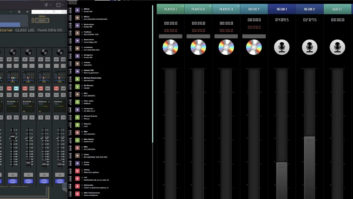The author is radio marketing specialist for Lawo AG
If you think about it, broadcasting and IT are nearly twins. They’re both about communication and information. And lately, they’ve been moving even closer.

In 2005, studios using switched Ethernet for audio transport were exotic; now AoIP is commonplace. PCs supply the lion’s share of most stations’ daily audio, editing is performed on laptops and workstations, and even mixing consoles can be “virtual.” It’s fair to say that today, most radio engineers’ daily routines involve as much IT activity as RF — maybe more. Now, broadcasters are buzzing about the possibilities of another IT technology: “The cloud.”
WHAT IS THE CLOUD?
It’s a blanket term for internet-based services that provide computing power or mass storage or run applications from an off-site server. The cloud is an outgrowth of the enormous increase in computing power that replaced racks of physical computers with powerful “super servers,” each running dozens of virtual machines performing different tasks. Well-known CSPs [Cloud Service Providers] include Amazon Web Services, Microsoft Azure and Rackspace; there are many others.

Nearly every CSP offers two types of cloud services: public and private. Public cloud services are accessible to anyone with a public internet connection, and are great for delivering apps to a wide number of people or locations. Private cloud services require a dedicated peer connection from subscriber IPs to cloud servers, limiting access but increasing security for developers and creators.
HOW CAN BROADCASTERS USE THE CLOUD?
Thanks to ubiquitous Wi-Fi and cellular data services, radio consumers increasingly listen on phones, smart speakers and other connected devices instead of actual radios. Because of this, everyone agrees that program distribution via public cloud services is perfect for the distribution of radio content on the internet, whether live or on-demand.
This has become much easier and cost-effective recently, thanks to development of modern media protocols such as HLS and MPEG-DASH, which use pure HTTP transmission to deliver content instead of relying on RTSP and stream replicators. CSAs’ “big pipe” internet connections make cloud-based content distribution even more of a natural fit.
At the other end, cloud services can be leveraged to enhance content contribution. Some readers may already keep their music libraries, or even the automation system itself, on cloud-based servers — great for redundancy and guaranteed uptime.
Talk show conferencing and call-ins are another interesting application. Many cloud-based VoIP phone systems are already available tailored to the needs of broadcasters. These utilize software hybrids running in virtual machines to deliver clear digital caller audio to the studio, and mix-minus to callers and guests.
Content ingest is yet another area where cloud services shine. With the future of C-Band satellite services uncertain, syndicated content distribution via cloudservers (real-time or file-based) provides a viable and cost-effective replacement solution.

Perhaps the best use so far for cloud services is to provide broadcast tools on-demand for remote talent. Cloud-based audio production libraries, recording and editing software, and contribution methods give reporters, remote presenters and editors studio-grade tools — without the expense of building and maintaining off-site studios.
THE BIG QUESTION
When radio folks talk about the cloud services, one question invariably pops up: “Can I run my radio studio from the cloud?” While many of the tools needed for radio production are already virtualized and ready for use, there’s one barrier to completely virtualized studios hosted by CSPs: that old demon latency.
[Read: This Is Electric Broadcasts From the Cloud]
While it’s certainly possible to create, edit and mix programming with cloud-based software, the latency involved in transmitting local talent audio over the internet, mixing it and then sending it back for monitoring makes real-time content creation problematic unless a zero-latency local mix is employed to mirror the mixing being done by cloud-hosted software. Perhaps the future holds a solution to this problem, but for now, complete cloud-based studio virtualization remains out of reach.
TO USE OR NOT TO USE
Are cloud-based services right for your radio station? Here are some questions to help you decide.
1. Do you stream your programming? How much does it cost you? If you are already streaming using first-generation stream replication, moving to newer codecs in conjunction with cloud-based HTTP servers might reduce your overall cost per stream.
2. How much of your programming comes from external sources? If much of your programming is already from externally delivered content, moving more services (such as automation and content libraries) to cloud-based servers may make financial sense. But if most or all of your content is locally created, cloud services will likely not be useful to you.
3. Do you have remote contributors? If your organization has creators and editors working while travelling, or from satellite locations or home studios, it may be worth converting remote-studio hardware into cloud-hosted production tools that can be accessed on-demand from any place with an internet connection, and require no physical replacement or maintenance.
As computing power and internet availability continue to rise, it’s clear that cloud services will play a part in the future of radio. How much a part? As always, one size does not fit all. The role of cloud-based services in your operations will always depend on your unique needs and the services available.







